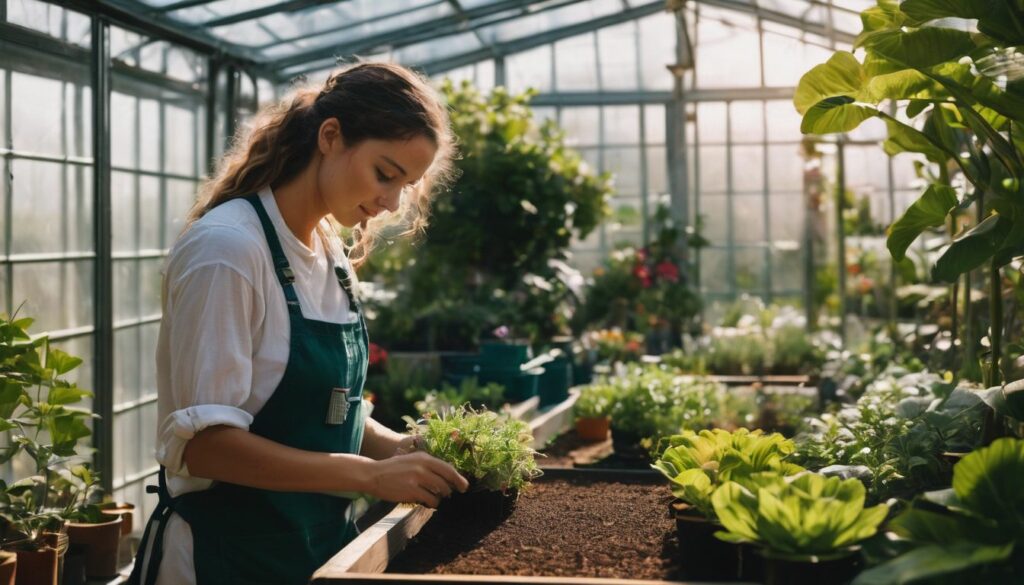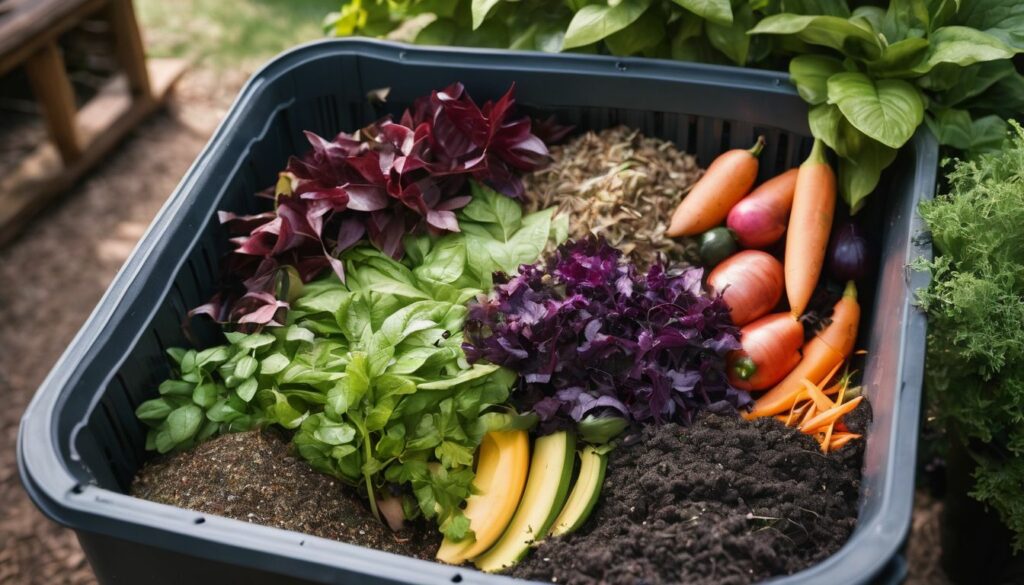Does the idea of self-sufficiency and sustainable living whisper promises of a fulfilling lifestyle to you? You’re in good company. Many others, including myself, have been captivated by the dream of homesteading, preserving resources, and minimizing our carbon footprint – just as over a million other Americans who have embraced this way of life.
This blog is your guide to 33 hands-on homesteading ideas designed to inspire anyone yearning for greater independence. Are you ready to embark on an adventure towards self-reliance? Let’s dive in!
Key Takeaways
- Homesteading is about living a self – sufficient lifestyle by growing your own food and keeping animals for eggs, meat, or milk.
- Essential components of a homestead include a growing space for gardening, a reliable water source, a composting system to reduce waste, and ample storage space.
- Tips for starting a homestead include evaluating your space, making a list of projects and prioritizing them, starting small and DIY, learning how to preserve food, never stop learning new skills, and finding creative ways to afford homesteading.
- Practical homesteading ideas include backyard homestead ideas like starting an herb garden or planter garden; small-scale ideas like container gardening or raising backyard chickens; and sustainable practices like rainwater harvesting or off-grid options.
What is Homesteading?
Homesteading is a way to live. It is about doing things by yourself and for your family. You grow food on your own land or in pots if space is tiny. You also keep animals, like chickens or goats, for eggs, meat, or milk.
Not every homesteader does this full time. Some just enjoy the fun of gardening at home.
People fancy homesteading because it lets them control what they eat and use around their house. Plus, it’s amazing how much you can save when you make things instead of buying them! Homesteaders get to choose how pure their food is and say no to harmful chemicals that taint most store-bought foods today.
Essential Components of a Homestead
A successful homestead requires several essential components, including a growing space for gardening, a reliable water source, a composting system for organic waste, and ample storage space for supplies and harvested food.
Growing space
One important component of a homestead is having enough space to grow your own food. Whether you have a backyard or just a small patch of land, there are plenty of ideas for creating a productive growing space.
You can start by building raised beds or using containers to grow vegetables and herbs. It’s also worth considering vertical gardening, where you use trellises or hanging baskets to maximize your growing area.
Another option is to create a community garden with neighbors or join an existing one in your area. This allows you to share resources and knowledge while cultivating a sense of community.
Water source
Water is an essential component of any homestead. It is important to have a reliable water source for various activities such as gardening, livestock care, and household use. Rainwater harvesting is a sustainable way to collect and store water for irrigation purposes.
Installing rain barrels or cisterns can help capture rainwater from rooftops. Additionally, creating a well or utilizing natural bodies of water like ponds or streams can provide a continuous supply of water.
It’s crucial to have access to clean and safe drinking water by installing filtration systems or investing in portable purification devices. Conserving water through efficient irrigation methods and repairing leaks is also important for sustainable living on the homestead.
Composting system
Composting is a practical and eco-friendly way to reduce waste and create nutrient-rich soil for your garden. It’s easy to start your own composting system right in your backyard. All you need is a designated area or bin where you can collect organic materials like fruit and vegetable scraps, coffee grounds, and yard trimmings.
These materials will break down over time, thanks to the work of beneficial microorganisms, into dark, crumbly compost that can be used as fertilizer for your plants. Composting not only helps you save money on buying fertilizers but also reduces the amount of waste that ends up in landfills.
So why not give it a try? Start composting today!
Storage space
One essential component of a homestead is having enough storage space. This allows you to store all the tools, equipment, and supplies you need for your self-sufficient lifestyle. A well-organized storage area ensures that everything has its place and is easily accessible when needed.
You can use shelving units, cabinets, or even repurpose old furniture for storage. Utilize containers, jars, or bins to keep smaller items organized. It’s important to have a designated space for food preservation as well, such as a pantry or root cellar.
Adequate storage space on your homestead helps you stay organized and ensures that everything is in its proper place when you need it most.
Tips for Starting a Homestead
Evaluate your space, make a list of projects and prioritize them, start small and DIY, learn how to preserve food, never stop learning new skills, and find creative ways to afford homesteading.
Evaluate your space
Before starting your homesteading journey, it’s essential to evaluate the space you have available. This can help determine what activities and projects are feasible for your homestead.
Consider factors such as the size of your backyard or land, sunlight exposure, soil quality, and access to water sources. By assessing these elements, you can make informed decisions about what crops to grow, where to place structures like compost bins or chicken coops, and how much livestock you can raise.
Taking the time to evaluate your space ensures that you maximize its potential and create a sustainable and productive homestead tailored to your specific circumstances.
Make a list of projects and prioritize
To start your homesteading journey, it’s important to make a list of projects and prioritize them. This will help you stay organized and ensure that you tackle the most important tasks first.
Consider what areas of self-sufficiency are most important to you, such as gardening, raising livestock, or renewable energy. Then, break down these larger goals into smaller, more manageable projects.
For example, if vegetable gardening is a priority for you, some projects could include building raised beds or creating a composting system. By having a clear plan in place and prioritizing your projects accordingly, you’ll be able to take small steps towards your self-sufficient lifestyle.
Start small and DIY
I love the idea of starting small and doing it yourself when it comes to homesteading. It’s a great way to learn and gain confidence in your abilities. You can begin by creating a small container garden on your patio or balcony, growing herbs or vegetables that you use often in your cooking.
DIY projects like building raised beds or making homemade compost bins are also fantastic ways to start small and save money. By taking these initial steps, you’ll be on your way to creating a more self-sufficient lifestyle while enjoying the satisfaction of doing it yourself.
Learn how to preserve
Preserving food is an important skill for homesteaders to learn. By preserving food, you can extend the lifespan of your harvest and reduce waste. There are different methods of preservation, including canning, drying, freezing, and fermenting.
Canning involves sealing food in jars with heat to kill bacteria and prevent spoilage. Drying removes moisture from fruits, vegetables, or herbs to prevent microbial growth. Freezing is a simple method that requires placing fresh produce in freezer-safe containers or bags.
Fermenting involves using beneficial bacteria or yeast to preserve food and develop unique flavors. By learning how to preserve your harvest, you can enjoy homegrown food all year round and reduce dependence on store-bought produce.
Never stop learning
As a self-sufficient enthusiast, it’s important to never stop learning. There is always something new to discover and improve upon when it comes to homesteading. Whether it’s trying out different gardening techniques, learning about sustainable livestock management, or exploring new ways to preserve food, continuous learning is essential for success.
By staying curious and open-minded, you can keep expanding your knowledge and skills in order to create a more self-reliant and eco-friendly homestead. Remember that there are many resources available such as books, online courses, workshops, and fellow homesteaders who can provide valuable insights and guidance along the way.
Embrace the mindset of lifelong learning and let your homesteading journey be a constant opportunity for growth and discovery.
How to afford homesteading
Homesteading can be affordable with some smart strategies. One way is to evaluate your space and make the most of what you have. Start small and prioritize projects based on their cost and benefit.
Don’t be afraid to do things yourself – DIY projects can save you money. Learn how to preserve food, so you can make the most of your harvest. And never stop learning – there are many resources available to help you become more self-sufficient without breaking the bank.
By being resourceful and creative, anyone can afford homesteading and enjoy a more sustainable lifestyle.
Practical Homesteading Ideas for Every Homesteader
In this section, we will explore a variety of practical homesteading ideas that can be implemented by anyone, regardless of the size of their space or level of experience.
Backyard homestead ideas
In my journey towards self-sufficiency, I discovered some fantastic backyard homestead ideas that can help anyone create a more sustainable and eco-friendly lifestyle. One idea is to start a kitchen herb garden.
Not only does this provide fresh herbs for cooking, but it also saves money and reduces waste from store-bought herbs. Another great idea is to start a planter garden in your backyard.
This allows you to grow vegetables even if you have limited space or poor soil quality. You can even try raising backyard chickens for eggs and meat! It’s surprising how much food you can produce right in your own backyard.
Another interesting option is an edible lawn, where traditional grass is replaced with edible plants like strawberries or blueberries. This not only provides food for your family but also adds beauty and diversity to your outdoor space.
Building a compost pile is another practical idea for any homesteader. It helps reduce waste by turning kitchen scraps into nutrient-rich soil that can be used in the garden.
Small homestead ideas
If you have limited space for your homestead, don’t worry! There are plenty of small-scale ideas you can try. One option is to create a container garden on your balcony or patio. This allows you to grow herbs, vegetables, or even mushrooms in pots or planters.
Another idea is to explore the world of foraging and learn about edible plants that grow wild in your area. You can also consider raising backyard chickens if local regulations permit it.
Just a few hens can provide you with fresh eggs every day. Finally, rainwater harvesting is a great way to make the most of limited resources by collecting water from your roof and using it for watering plants or even flushing toilets.
Off-grid homestead ideas
Living off-grid is a great way to become self-sufficient and reduce your carbon footprint. Here are some practical ideas for creating an off-grid homestead:.
1. Generate renewable energy: Install solar panels or wind turbines to power your home without relying on the grid.
2. Harvest rainwater: Collect rainwater in barrels or tanks to use for irrigation, cleaning, and other non-potable purposes.
3. Practice permaculture: Create a sustainable food system by designing your garden in a way that mimics natural ecosystems and maximizes efficiency.
4. Implement passive heating and cooling systems: Use smart design techniques such as proper insulation, thermal mass, shading, and ventilation to maintain comfortable temperatures year-round.
5. Invest in energy-efficient appliances: Choose appliances with high Energy Star ratings to minimize electricity usage.
6. Utilize composting toilets: Reduce water consumption by using composting toilets instead of traditional flush toilets.
7. Grow your own food: Establish a vegetable garden, fruit orchard, or raise livestock like chickens for eggs and meat to provide a steady supply of fresh food.
8. Preserve food through canning and dehydrating: Extend the shelf life of fruits, vegetables, and meats by canning or dehydrating them for later use when fresh produce is not available.
How to make money through homesteading
Making money through homesteading is possible by utilizing various income-generating opportunities. One way is to sell surplus produce from your garden or orchard at local farmers markets or through a farm stand.
You can also start a small-scale honey business by harvesting and selling honey from your own beehives. Another option is to raise livestock, such as chickens for eggs or goats for milk, and sell the products they provide.
Additionally, you can offer workshops or classes on gardening, composting, or other homesteading skills to people in your community. By diversifying your sources of income and leveraging the resources available on your homestead, you can supplement your self-sufficient lifestyle with some extra cash flow.
Homestead name ideas
Choosing the perfect name for your homestead is an exciting part of the journey. It’s a chance to showcase your unique personality and what your homestead represents. When brainstorming homestead names, consider incorporating elements that are meaningful to you and reflect the purpose of your self-sufficient lifestyle.
You could use words like “Sustainable Haven,” “Harvest Homestead,” or “Nature’s Bounty Farm.” Another option is to play on words, like “Roots & Shoots” or “Farmstead Dreams.” Whatever name you choose, make sure it resonates with you and captures the essence of your self-reliant journey.
Additionally, some practical tips for coming up with a memorable homestead name include considering the environment around you – do you have lush green fields? Do you live near a river or lake? Incorporating these natural elements into your name can add a special touch.
Remember to keep it simple and easy to pronounce so that others can remember it easily too. Having a unique and catchy name will also help when marketing any products or services that come from your homestead.
Urban homesteading ideas
Living in an urban area doesn’t mean you can’t practice homesteading! There are plenty of ideas for creating a self-sufficient lifestyle right in your own backyard. You can start by growing a kitchen herb garden, which is practical and saves money on buying herbs from the store.
Another idea is to have a planter garden, where you can grow vegetables and fruits in containers. Community gardening is also a great option, allowing you to share resources and knowledge with others in your community.
And if you’re looking to replace your traditional grass lawn, consider turning it into an edible lawn filled with tasty and nutritious plants. By implementing these urban homesteading ideas, you’ll be well on your way to living a more sustainable and self-reliant lifestyle.
Conclusion
In conclusion, “33 Practical Homesteading Ideas for Every Self-Sufficient Enthusiast” offers a wealth of accessible, sustainable living tips for individuals of all backgrounds. Whether you have a small backyard or live in an urban environment, there are ideas and resources to help you become more self-reliant and eco-friendly.
From growing your own herbs and vegetables to raising backyard chickens or exploring off-grid options, the possibilities are endless. So start small, learn as you go, and embrace the rewarding journey towards self-sufficiency.
FAQs
1. What are some practical homesteading ideas for self-sufficient living?
Practical homesteading ideas include herb gardening, mushroom cultivation, and setting up an aquaponics system to promote a self-reliant lifestyle.
2. How can I create cost-effective solutions with homesteading?
DIY projects like organic gardening and livestock farming are great cost-cutting strategies that also provide eco-friendly practices for sustainable living.
3. Can I practice independent living in the city?
Yes! Urban farming is a popular backyard self-sufficiency strategy among those pursuing green living suggestions in cities.
4. Is there any resourceful way for preserving my farm produce?
Canning and preserving your home-grown foods is a smart way to extend their life while embracing off-grid living as part of your homesteading practices.
5. What can be done to improve soil fertility on my homestead?
One eco-friendly tip is using green manure from your livestock farming which helps enrich the soil, promoting healthier crops on your land.





